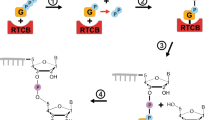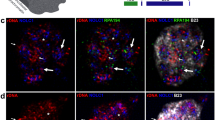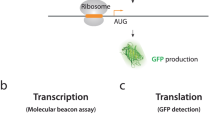Abstract
Yeast ribosomal protein L11 is positioned at the intersubunit cleft of the large subunit central protuberance, forming an intersubunit bridge with the small subunit protein S18. Mutants were engineered in the central core region of L11 which interacts with Helix 84 of the 25S rRNA. Numerous mutants in this region conferred 60S subunit biogenesis defects. Specifically, many mutations of F96 and the A66D mutant promoted formation of halfmers as assayed by sucrose density ultracentrifugation. Halfmer formation was not due to deficiency in 60S subunit production, suggesting that the mutants affected subunit-joining. Chemical modification analyses indicated that the A66D mutant, but not the F96 mutants, promoted changes in 25S rRNA structure, suggesting at least two modalities for subunit joining defects. 25S rRNA structural changes were located both adjacent to A66D (in H84), and more distant (in H96-7). While none of the mutants significantly affected ribosome/tRNA binding constants, they did have strong effects on cellular growth at both high and low temperatures, in the presence of translational inhibitors, and promoted changes in translational fidelity. Two distinct mechanisms are proposed by which L11 mutants may affect subunit joining, and identification of the amino acids associated with each of these processes are presented. These findings may have implications for our understanding of multifaceted diseases such as Diamond–Blackfan anemia which have been linked in part with mutations in L11.







Similar content being viewed by others
References
Acker MG, Shin BS, Dever TE, Lorsch JR (2006) Interaction between eukaryotic initiation factors 1A and 5B is required for efficient ribosomal subunit joining. J Biol Chem 281:8469–8475
Acker MG, Shin BS, Nanda JS, Saini AK, Dever TE, Lorsch JR (2009) Kinetic analysis of late steps of eukaryotic translation initiation. J Mol Biol 385:491–506
Boria I, Garelli E, Gazda HT, Aspesi A, Quarello P, Pavesi E, Ferrante D, Meerpohl JJ, Kartal M, Da Costa L, Proust A, Leblanc T, Simansour M, Dahl N, Frojmark AS, Pospisilova D, Cmejla R, Beggs AH, Sheen MR, Landowski M, Buros CM, Clinton CM, Dobson LJ, Vlachos A, Atsidaftos E, Lipton JM, Ellis SR, Ramenghi U, Dianzani I (2010) The ribosomal basis of Diamond–Blackfan anemia: mutation and database update. Hum Mutat 31:1269–1279
Breinig F, Tipper DJ, Schmitt MJ (2002) Kre1p, the plasma membrane receptor for the yeast K1 viral toxin. Cell 108:395–405
Carter AP, Clemons WM, Brodersen DE, Morgan-Warren RJ, Wimberly BT, Ramakrishnan V (2000) Functional insights from the structure of the 30S ribosomal subunit and its interactions with antibiotics. Nature 407:340–348
DeLano WL (2002) The PyMOL molecular graphics system. DeLano scientific. San Carlos, CA
Dinman JD (2006) Programmed ribosomal frameshifting goes beyond viruses: organisms from all three kingdoms use frameshifting to regulate gene expression, perhaps signaling a paradigm shift. Microbe 1:521–527
Dinman JD, Wickner RB (1992) Ribosomal frameshifting efficiency and Gag/Gag-pol ratio are critical for yeast M1 double-stranded RNA virus propagation. J Virol 66:3669–3676
Dinman JD, Icho T, Wickner RB (1991) A −1 ribosomal frameshift in a double-stranded RNA virus forms a Gag-pol fusion protein. Proc Natl Acad Sci USA 88:174–178
Dresios J, Derkatch IL, Liebman SW, Synetos D (2000) Yeast ribosomal protein L24 affects the kinetics of protein synthesis and ribosomal protein L39 improves translational accuracy, while mutants lacking both remain viable. Biochemistry 39:7236–7244
Fischer N, Konevega AL, Wintermeyer W, Rodnina MV, Stark H (2010) Ribosome dynamics and tRNA movement by time-resolved electron cryomicroscopy. Nature 466:329–333
Gazda HT, Sheen MR, Vlachos A, Choesmel V, O’Donohue MF, Schneider H, Darras N, Hasman C, Sieff CA, Newburger PE, Ball SE, Niewiadomska E, Matysiak M, Zaucha JM, Glader B, Niemeyer C, Meerpohl JJ, Atsidaftos E, Lipton JM, Gleizes PE, Beggs AH (2008) Ribosomal protein L5 and L11 mutations are associated with cleft palate and abnormal thumbs in Diamond–Blackfan anemia patients. Am J Hum Genet 83:769–780
Grifo JA, Tahara SM, Morgan MA, Shatkin AJ, Merrick WC (1983) New initiation factor activity required for globin mRNA translation. J Biol Chem 258(9):5804–5810
Grollman AP (1967) Inhibitors of protein biosynthesis. II. Mode of action of anisomycin. J Biol Chem 242:3226–3233
Gryk MR, Marintchev A, Maciejewski MW, Robertson A, Wilson SH, Mullen GP (2002) Mapping of the interaction interface of DNA polymerase beta with XRCC1. Structure 10:1709–1720
Hansen JL, Moore PB, Steitz TA (2003) Structures of five antibiotics bound at the peptidyl transferase center of the large ribosomal subunit. J Mol Biol 330:1061–1075
Harger JW, Dinman JD (2003) An in vivo dual-luciferase assay system for studying translational recoding in the yeast Saccharomyces cerevisiae. RNA 9:1019–1024
Harger JW, Meskauskas A, Dinman JD (2002) An ‘integrated model’ of programmed ribosomal frameshifting and post-transcriptional surveillance. Trends Biochem Sci 27:448–454
Jackson RJ, Hellen CU, Pestova TV (2010) The mechanism of eukaryotic translation initiation and principles of its regulation. Nat Rev Mol Cell Biol 11:113–127
Jacobs JL, Dinman JD (2004) Systematic analysis of bicistronic reporter assay data. Nucleic Acids Res 32:e160–e170
Kellis M, Birren BW, Lander ES (2004) Proof and evolutionary analysis of ancient genome duplication in the yeast Saccharomyces cerevisiae. Nature 428:617–624
Kiparisov S, Petrov A, Meskauskas A, Sergiev PV, Dontsova OA, Dinman JD (2005) Structural and functional analysis of 5S rRNA in Saccharomyces cerevisiae. Mol Genet Genomics 274:235–247
Kozak M (1980) Role of ATP in binding and migration of 40S ribosomal subunits. Cell 22:459–467
Leer RJ, Raamsdonk-Duin MM, Mager WH, Planta RJ (1984) The primary structure of the gene encoding yeast ribosomal protein L16. FEBS Lett 175:371–376
Liao PY, Choi YS, Dinman JD, Lee KH (2011) The many paths to frameshifting: kinetic modelling and analysis of the effects of different elongation steps on programmed -1 ribosomal frameshifting. Nucleic Acids Res 39:300–312
Meskauskas A, Dinman JD (2007) Ribosomal protein L3: gatekeeper to the A-site. Mol Cell 25:877–888
Meskauskas A, Dinman JD (2008) Ribosomal protein L3 functions as a ‘rocker switch’ to aid in coordinating of large subunit-associated functions in eukaryotes and archaea. Nucleic Acids Res 36:6175–6186
Meskauskas A, Harger JW, Jacobs KLM, Dinman JD (2003) Decreased peptidyltransferase activity correlates with increased programmed −1 ribosomal frameshifting and viral maintenance defects in the yeast Saccharomyces cerevisiae. RNA 9(8):982–992
Meskauskas A, Russ JR, Dinman JD (2008) Structure/function analysis of yeast ribosomal protein L2. Nucleic Acids Res 36:1826–1835
Moritz M, Pulaski BA, Woolford JL Jr (1991) Assembly of 60S ribosomal subunits is perturbed in temperature-sensitive yeast mutants defective in ribosomal protein L16. Mol Cell Biol 11:5681–5692
Nariai M, Tanaka T, Okada T, Shirai C, Horigome C, Mizuta K (2005) Synergistic defect in 60S ribosomal subunit assembly caused by a mutation of Rrs1p, a ribosomal protein L11-binding protein, and 3′-extension of 5S rRNA in Saccharomyces cerevisiae. Nucleic Acids Res 33:4553–4562
Ohtake Y, Wickner RB (1995) Yeast virus propagation depends critically on free 60S ribosomal subunit concentration. Mol Cell Biol 15:2772–2781
Pestova TV, Borukhov SI, Hellen CU (1998) Eukaryotic ribosomes require initiation factors 1 and 1A to locate initiation codons. Nature 394:854–859
Pestova TV, Lomakin IB, Lee JH, Choi SK, Dever TE, Hellen CU (2000) The joining of ribosomal subunits in eukaryotes requires eIF5B. Nature 403:332–335
Petrov AN, Meskauskas A, Roshwalb SC, Dinman JD (2008) Yeast ribosomal protein L10 helps coordinate tRNA movement through the large subunit. Nucleic Acids Res 36:6187–6198
Pisarev AV, Kolupaeva VG, Pisareva VP, Merrick WC, Hellen CU, Pestova TV (2006) Specific functional interactions of nucleotides at key −3 and +4 positions flanking the initiation codon with components of the mammalian 48S translation initiation complex. Genes Dev 20:624–636
Plant EP, Nguyen P, Russ JR, Pittman YR, Nguyen T, Quesinberry JT, Kinzy TG, Dinman JD (2007) Differentiating between near- and non-cognate codons in Saccharomyces cerevisiae. PLoS ONE 2:e517
Rakauskaite R, Dinman JD (2006) An arc of unpaired “hinge bases” facilitates information exchange among functional centers of the ribosome. Mol Cell Biol 26:8992–9002
Rakauskaite R, Dinman JD (2008) rRNA mutants in the yeast peptidyltransferase center reveal allosteric information networks and mechanisms of drug resistance. Nucleic Acids Res 36:1497–1507
Rhodin MHJ, Dinman JD (2010) A flexible loop in yeast ribosomal protein L11 coordinates P-site tRNA binding. Nucleic Acids Res 38:8377–8389
Rhodin MHJ, Dinman JD (2011) An extensive network of information flow through the B1b/c intersubunit bridge of the yeast ribosome. PLoS ONE (in press)
Roll-Mecak A, Cao C, Dever TE, Burley SK (2000) X-Ray structures of the universal translation initiation factor IF2/eIF5B: conformational changes on GDP and GTP binding. Cell 103:781–792
Rotenberg MO, Moritz M, Woolford JL Jr (1988) Depletion of Saccharomyces cerevisiae ribosomal protein L16 causes a decrease in 60S ribosomal subunits and formation of half-mer polyribosomes. Genes Dev 2:160–172
Schlunzen F, Zarivach R, Harms R, Bashan A, Tocilj A, Albrecht R, Yonath A, Franceschi F (2001) Structural basis for the interaction of antibiotics with the peptidyl transferase centre in eubacteria. Nature 413:814–821
Schuwirth BS, Borovinskaya MA, Hau CW, Zhang W, Vila-Sanjurjo A, Holton JM, Cate JH (2005) Structures of the bacterial ribosome at 3.5 Å resolution. Science 310:827–834
Spahn CM, Beckmann R, Eswar N, Penczek PA, Sali A, Blobel G, Frank J (2001) Structure of the 80S ribosome from Saccharomyces cerevisiae–tRNA- ribosome and subunit-subunit interactions. Cell 107:373–386
Spahn CM, Gomez-Lorenzo MG, Grassucci RA, Jorgensen R, Andersen GR, Beckmann R, Penczek PA, Ballesta JP, Frank J (2004) Domain movements of elongation factor eEF2 and the eukaryotic 80S ribosome facilitate tRNA translocation. EMBO J 23:1008–1019
Stern S, Moazed D, Noller HF (1988) Structural analysis of RNA using chemical and enzymatic probing monitored by primer extension. Methods Enzymol 164:481–489
Taylor DJ, Devkota B, Huang AD, Topf M, Narayanan E, Sali A, Harvey SC, Frank J (2009) Comprehensive molecular structure of the eukaryotic ribosome. Structure 17:1591–1604
Unbehaun A, Borukhov SI, Hellen CU, Pestova TV (2004) Release of initiation factors from 48S complexes during ribosomal subunit joining and the link between establishment of codon-anticodon base-pairing and hydrolysis of eIF2-bound GTP. Genes Dev 18:3078–3093
Wickner RB (1996) Double-stranded RNA viruses of Saccharomyces cerevisiae. Microbiol Rev 60:250–265
Wilkinson KA, Merino EJ, Weeks KM (2006) Selective 2′-hydroxyl acylation analyzed by primer extension (SHAPE): quantitative RNA structure analysis at single nucleotide resolution. Nat Protoc 1:1610–1616
Wolfe KH, Shields DC (1997) Molecular evidence for an ancient duplication of the entire yeast genome. Nature 387:708–713
Yusupov MM, Yusupova GZ, Baucom A, Lieberman K, Earnest TN, Cate JH, Noller HF (2001) Crystal structure of the ribosome at 5.5 Å resolution. Science 292:883–896
Zanchin NI, Roberts P, DeSilva A, Sherman F, Goldfarb DS (1997) Saccharomyces cerevisiae Nip7p is required for efficient 60S ribosome subunit biogenesis. Mol Cell Biol 17:5001–5015
Acknowledgments
We would like to thank Dr. Arturas Meskauskas, Dr. Karen Jack, Hamid-Reza Shahshahan, Ashton Trey Belew, Sharmishtha Musalgaonkar, and the rest of our laboratory for their help and support. We thank Dr. Pamela Silver for providing us with L11 yeast strain PSY2088. This work was supported by a grant to JDD from the National Institutes of Health (R01 GM058859).
Conflict of interest
The authors declare they have no conflict of interest.
Author information
Authors and Affiliations
Corresponding author
Additional information
Communicated by T. Ito.
Electronic supplementary material
Below is the link to the electronic supplementary material.
Rights and permissions
About this article
Cite this article
Rhodin, M.H.J., Rakauskaitė, R. & Dinman, J.D. The central core region of yeast ribosomal protein L11 is important for subunit joining and translational fidelity. Mol Genet Genomics 285, 505–516 (2011). https://doi.org/10.1007/s00438-011-0623-2
Received:
Accepted:
Published:
Issue Date:
DOI: https://doi.org/10.1007/s00438-011-0623-2




